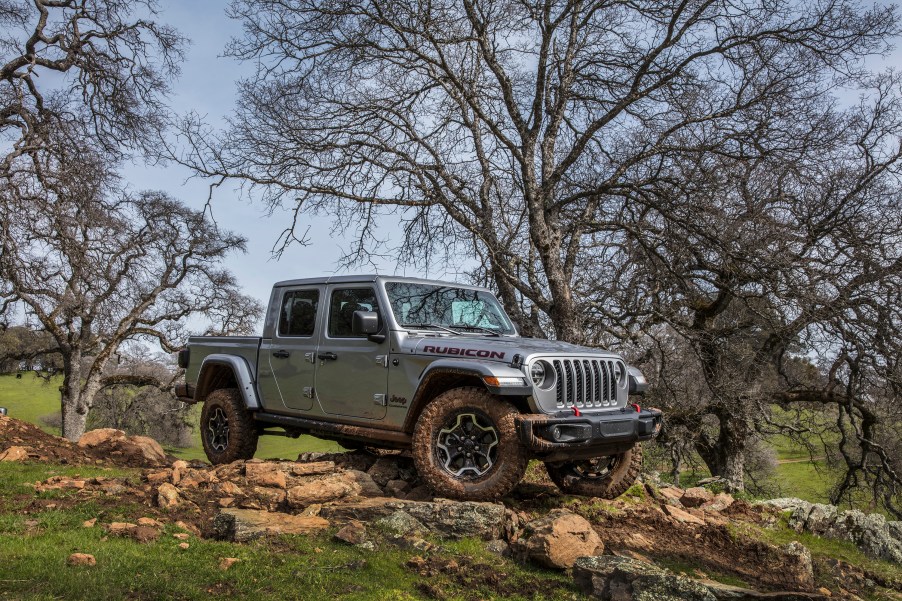
Should You Buy the Manual Transmission Jeep Gladiator?
If you love midsize trucks and driving a stick shift, there aren’t a lot of choices. Buyers could only choose from the five-speed Nissan Frontier or the six-speed Toyota Tacoma. Until this year. Jeep has brought back the Gladiator, and it’s being offered with a manual transmission. But while there are a lot of positives about the Gladiator, the manual option doesn’t seem to be one of them.
New Jeep Gladiator
The 2020 Gladiator is Jeep’s first pickup truck in more than 25 years. The original Jeep Gladiator truck appeared for 1963. In 1970, AMC bought the Kaiser Jeep Company, and the Gladiator name stopped being used in 1971. Jeep trucks were then called the J-Series until 1987 when Jeep was purchased by Chrysler and stopped making midsize trucks. (The Jeep Comanche continued until 1992.)
Jeep concept trucks started appearing in the mid-2000s, and the 2020 Gladiator is the first one for production. It has four trim levels available: Sport, Sport S, Overland, and Rubicon.
Manual isn’t worth it
A six-speed manual is the standard transmission on all trims, so an automatic transmission is an optional $2,000 upgrade. This extra cost is likely an easy decision for buyers who want better road performance and higher towing capabilities. The automatic is also easier to drive and much less likely to stall. The 2020 Jeep Gladiator has a base price of $35,040, and a manual Sport trim tested by Motor Trend was priced at $46,185.
Acceleration isn’t great
When Motor Trend tested the manual Sport trim, they found that it was a hair faster to 60 mph than the automatic Rubicon trim that they also tested. They attributed the difference to the lower weight of the manual Sport. The gears also shift at different speeds between the manual and the automatic.
While it might go zero to 60 slightly faster, Motor Trend’s review did find that the Aisin D478 transmission isn’t well matched to the 3.6-liter V-6 engine. “All the gears are too long,” mentioned Motor Trend features editor Christian Seabaugh. “First goes through 31 mph, second through 60, and third through 103. For a truck that’s supposed to work or go off-road that’s, frankly, insane.” The shift speeds are slightly lower on the Rubicon or with the Sport Max Tow package. Redline Reviews also drove the manual Gladiator and described it as feeling “lethargic.”
Manual tows less
The manual Gladiator has a smaller towing capacity than the automatic, a difference between 4,500 and 7,000 lbs in the Rubicon. Motor Trend’s test when pulling a trailer found that shifting from second gear to third caused the torque curve to drop off. Also, when pulling a 4,000-pound trailer, they found the acceleration time from zero to 60 mph more than doubled, going from 7.9 to 15.9 seconds. Another problem when pulling a trailer is that it’s difficult to see using the small door mirrors.
Right now, there’s only one powertrain option, a 3.6-liter Pentastar V-6 that generates 285 hp and 260 lb-ft of torque. However, next year, there will be a diesel option, a 3.0-liter diesel V-6 with 260 hp and 442 lb-ft, which will have torque and improve towing capabilities.
Small comfort issues
Reviewers had complaints about both the shifter and the lack of a footrest. Motor Trend found the shifter is designed differently from other vehicles, with long throws and an angle toward the driver. It takes extra effort to shift the gear. Redline Reviews disagreed, describing it as having “pretty good throws.” There’s also a comfort issue for the feet because there isn’t a dead pedal to support the driver’s left foot when it’s not on the clutch. The driver’s foot has to rest on the floor.
While there’s a lot of excitement to have a new Jeep truck available, the automatic may be worth the extra cost.


